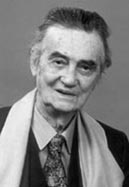|
|
 |
Charles le Gai Eaton (1921-2010) was born in Lausanne, Switzerland of British parents. He was educated at Charterhouse and Kings College, Cambridge. After wartime service in the British Intelligence Corps, his professional life included diplomatic service, teaching, and journalism, all of which took him to four continents. His writings challenged many of the operating principles of modern, and thus secular, societies. They do so by contrasting prevalent ideas about human nature with the traditional view of man as pontifex or “God’s viceroy on earth.” Writing on religion, philosophy, politics and society, Eaton maintained that people are always free inwardly to shape their ultimate destinies. In his later years, Gai Eaton worked as a consultant to the Islamic Cultural Center in London.
Although he wrote extensively on Islam, his most famous book was probably King of the Castle: Choice and Responsibility in the Modern World, considered by many to be a classic of the genre.
Charles le Gai Eaton contributed numerous articles to various issues of Studies.
|
|
|
|
 |
Mouse over this icon to see the abstract of the article. |
• Click on the header on any column to sort.
• Click on an issue listing (e.g. "Vol. 1, No. 1. ( Winter, 1967)" ) to see the full contents of only that issue.
|
| Article |

| Knowledge and the Sacred: Reflections on Seyyed Hossein Nasr’s Gifford Lectures | Eaton, Gai | |
Vol. 15, No. 3 and 4. ( Summer-Autumn, 1983)
| Comparative Religion |
| Article |

| What We Are and Where We Are | Eaton, Gai | |
Vol. 8, No. 3. ( Summer, 1974)
| Comparative Religion |
| Article |

It is often believed that the mythology of "primitive" peoples represents nothing more than an early effort to explain the universe rationally and is meant to be taken literally. Therefore, attention is shifted away from myth in favor of more highly developed forms of scientific investigation. This understanding, which assumes in modern man an evolutionary superiority, overlooks the symbolic message contained within the myths of such cultures. A similar form of rationalistic attack is often conducted against religious doctrine, and has contributed to such the virtual dissapearance of the metaphysicial and intellectual heritage within Christianity. Gai Eaton discusses these and other instances in which failure to comprehend the depth of a spiritual reality leads to its dismissal as irrelevant or absurd.
| The Only Heritage We Have | Eaton, Gai | |
Vol. 8, No. 2. ( Spring, 1974)
| Comparative Religion |
| Article |

| Knowledge and its Counterfeit | Eaton, Gai | |
Vol. 8, No. 1. ( Winter, 1974)
| Comparative Religion |
| Article |

Gai Eaton contrasts the increasingly prevalent view that man is in no way essentially different from other animals and therefore has no special rights with a doctrine characteristic of several spiritual traditions: that man is unique and granted certain privileges as well as obligated to uphold certain responsibilites. He explains how man has failed to meet these responsibilites by abusing animals and other natural resources, as well as behaving harmfully towards other men. Eaton uses the destruction of American Indian civilization as the primary illustration of the latter tendency.
| Man as Viceroy | Eaton, Gai | |
Vol. 7, No. 4. ( Autumn, 1973)
| Comparative Religion |
| Book Review |

Gai Eaton reviews Sacred Art in East and West: Its Principles and Methods by Titus Burckhardt, a book he calls “a study of what real art has been in the past and of what it still is in those few regions of the world that have not yet been completely overrun by modernism.” The book focuses on the sacred art of Hinduism, Christianity, Islam, Buddhism and Taoism.
| Sacred Art in East and West: Its Principles and Methods | Burckhardt, Titus * | Eaton, Gai |
Vol. 3, No. 1. ( Winter, 1969)
| Comparative Religion |
|
6 entries
(Displaying results 1 - 6)
|
View : |
|
 |
Loading... |
|
Page:
[1]
of 1 pages
|
|
|
|